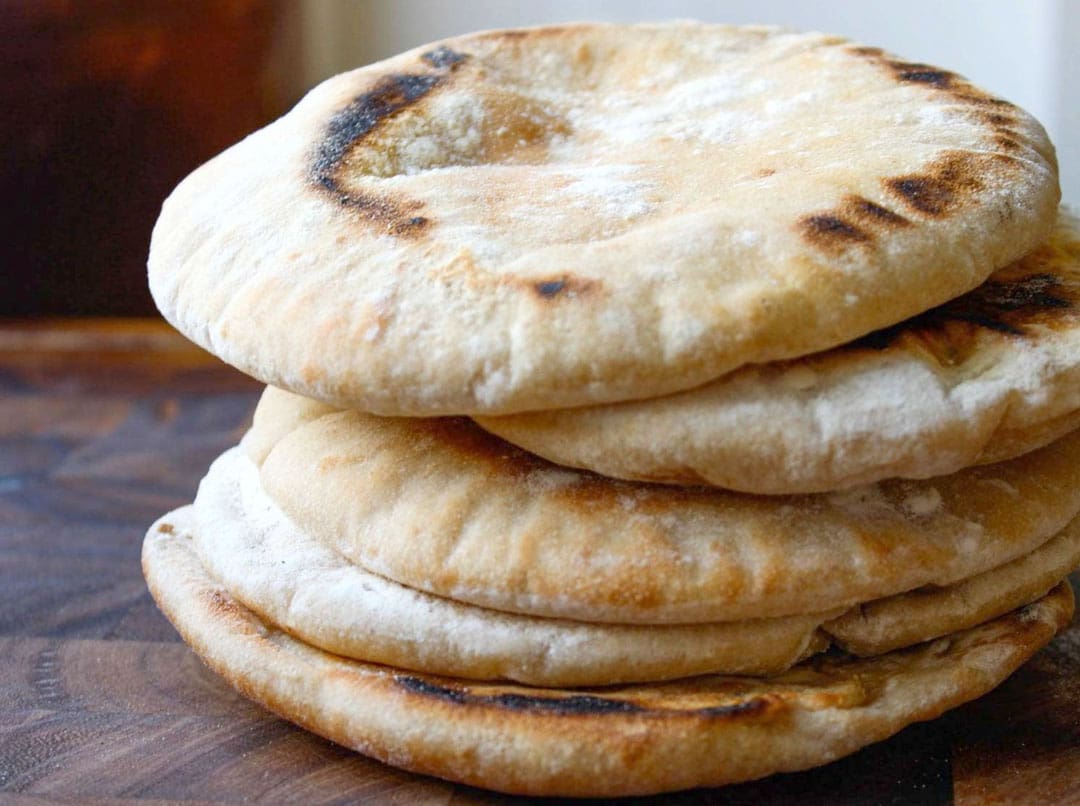
Discover the Health Benefits of Pita Bread
Could pita bread be a possible option for individuals trying to eat healthier?

Pita Bread
Pita bread is a yeast-leavened, round flatbread made with wheat flour. When baked, the dough turns into two layers. These layers create a pocket that can be filled with vegetables, meats, or vegetarian proteins. Pita bread offers health benefits because of its low carbohydrate count, the amount of nutrients in one serving, and the use of wheat flour.
Nutrition
Nutrition information for one serving of pita bread is 39 grams. (U.S. Department of Agriculture 2021)
- Carbohydrates – 17 grams
- Fat – 0.998 grams
- Protein – 4.02 grams
- Fiber – 1.99 grams
- Sodium – 120 milligrams
- Sugars – 0 grams
- Calories – 90.1
Carbohydrates
- The carbohydrate count for pita bread is 17 grams per serving or a little more than one carb count – 15 grams, used in meal planning for individuals with diabetes.
- Non-keto bread is around 20 grams of carbohydrates per serving or slice.
- Pita bread has a lower carbohydrate count than most breads.
Fats
- Pita breads are relatively low in fat content.
- The total lipid fat is under 2 grams, only 2% of the recommended daily amount or RDA.
- The bread contains no fatty acids or trans or saturated fat.
Protein
- Four grams of protein are in one serving of pita bread.
- The protein content is found in the wheat flour.
Vitamins and Minerals
Other minerals in pita bread include:
- Calcium, with 60.1 milligrams per serving.
- Iron with 1.08 milligrams per serving – helps the body create hemoglobin, a protein in red blood cells that carries oxygen from the lungs. (National Institute of Health, 2023)
- Sodium with 120 milligrams.
- According to the Federal Drug Administration, this is a low amount of sodium. However, individuals should stay aware of sodium intake and limit it to no more than 2,300 milligrams per day.
- The average adult consumes about 3,400 milligrams of sodium a day. (Food and Drug Administration, 2022)
Calories
- One serving of pita bread contains 90 calories.
- Pita bread for a sandwich contains fewer calories than two slices of regular bread.
Benefits
Potential health benefits include the following:
Glucose Levels Lowered
- Whole wheat can be beneficial to glucose levels.
- The American Diabetes Association suggests that choosing bread with whole wheat grains, like pita bread, instead of white bread, can work to keep blood sugar levels from spiking. (American Diabetes Association 2024)
Digestion Support
- Whole-grain pita bread fiber content can benefit the digestive system by regulating bowel movements.
- Complex carbohydrates are digested slower than simple carbohydrates, keeping the body fuller for longer and assisting in weight management. (Harvard Health 2022)
Protein Source
- Pita bread provides a healthy amount of protein.
- A serving contains around 8% of protein.
- Consuming the proper amount of protein helps in muscle repair. (Harvard Health 2024)
Allergies
Major allergies or intolerances can cause individuals to pass on the bread. What individuals need to know.
Celiac Disease
- Celiac disease is a heredity autoimmune disease that occurs in genetically predisposed individuals.
- Individuals with the disease cannot ingest gluten – a protein found in wheat – which can lead to small intestinal damage.
- Individuals who experience gastrointestinal distress when eating wheat should consult a healthcare professional to get tested. (Celiac Disease Foundation 2023)
Wheat Allergy
- A wheat allergy may mimic celiac disease symptoms, but they are different allergies.
- The allergy occurs when the body produces antibodies to wheat proteins.
- Symptoms include anaphylaxis, swelling and itching of the mouth, nasal congestion, headache, cramps, nausea, vomiting, and breathing difficulties. (American College of Allergy, Asthma, and Immunology 2024)
- Individuals who suspect a wheat allergy should consult a healthcare provider about an allergy test.
Gluten Intolerance
- Gluten intolerance can cause similar symptoms to celiac disease when eating products containing gluten.
- Symptoms include bloating, abdominal pain, constipation, joint pain, fatigue, brain fog, and depression. (Celiac Disease Foundation 2023)
Preparation
Pita bread preparation options.
- Dunk the bread in sauces or dips.
- Use the bread for pita-pocket sandwiches and fill it with meats and/or vegetables.
- Cut the bread and bake for pita chips.
- Cut the bread into small cubes and toast as an alternative to croutons for salads and soups.
- Grill the pita bread.
Diabetes and Back Pain
References
USDA. Pita Bread. (2021). Pita Bread. Retrieved from fdc.nal.usda.gov/fdc-app.html#/food-details/2134834/nutrients
National Institute of Health, Office of Dietary Supplements. (2023). Iron. Retrieved from ods.od.nih.gov/factsheets/Iron-HealthProfessional/
Food and Drug Administration. (2022). Sodium in your diet. Retrieved from www.fda.gov/food/nutrition-education-resources-materials/sodium-your-diet
American Diabetes Association. (2024). Types of carbohydrates (Food and Nutrition, Issue. diabetes.org/food-nutrition/understanding-carbs/types-carbohydrates
Harvard Health. (2022). Fiber (The Nutrition Source, Issue. www.hsph.harvard.edu/nutritionsource/carbohydrates/fiber/
Harvard Health. (2024). Protein (The Nutrition Source, Issue. www.hsph.harvard.edu/nutritionsource/what-should-you-eat/protein/
Celiac Disease Foundation. (2023). What is celiac disease? (About Celiac Disease, Issue. celiac.org/about-celiac-disease/what-is-celiac-disease/
American College of Allergy, Asthma, and Immunology. (2024). Wheat (Allergic Conditions, Issue. acaai.org/allergies/allergic-conditions/food/wheat-gluten/





